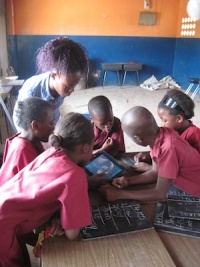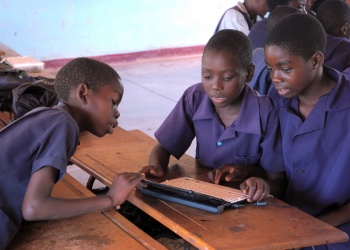Introduction to OER4Schools
Session 3 of Unit 1
Reflections from your own trial
![]() Small group (11 min). Share your reflections:
Small group (11 min). Share your reflections:
- What was the objective of the new lesson?
- How was the lesson interactive?
- How do you think the lesson went? In particular, how did learners respond?
- What would you change if you taught this again?
Using ICT to support interactive teaching
![]() Discuss (11 min). What is the role of ICT in the kinds of teaching this resource has been introducing?
Discuss (11 min). What is the role of ICT in the kinds of teaching this resource has been introducing?
See illustrations of ICT use:
First, remind yourself of Eness clip 5 – you may want to watch it again, this time looking at the ICT use.
Watch further videos:
VIDEO
Eness_vertebrates_5.mp4
The description of the video
Video/Eness vertebrates 5.mp4, https://oer.opendeved.net/wiki/Video/Eness_vertebrates_5.mp4, Duration: watch on YouTube, local play / download options / download from dropbox)
VIDEO
Abel clip 4.m4v
The description of the video
[[]], Template:Fullurl:, Duration:
VIDEO
12 13 Abel 2 4 rectangles
The description of the video
[[]], Template:Fullurl:, Duration:
VIDEO
12 13 Abel 2 4 rectangles
The description of the video
[[]], Template:Fullurl:, Duration:
- 19_Eness_vertebrates 5
- Abel clip 4.m4v (teacher introduces task, followed by some small groupwork –group is confused about area vs.perimeter so Abel asks older boys to help)
- 12 13 Abel 2 4 rectangles (group working on GeoGebra on their own; teacher interacts at end)
- Abel_student_presentation. Groups come up to the board to explain what they found and what they learned; this brief clip shows 2 girls presenting
Look at photographs from other lessons to see more examples of interactive teaching and ICT use.
- When is it appropriate to use ICT?
- What uses can you think of that promote and enhance interactive teaching and learning?
Discussion around appropriate use and purpose: ICT engages learners but may have novelty value. How can we keep its use motivating over time?
Resources
What resources are needed for interactive teaching – in general? Where do they come from?
ICTs are one resource but non-digital tools can be powerful too. Examples of resources include:
- mini-blackboards
- measuring tapes or sticks
- counters or stones
- calculators
- digital camera
- digital learning resources: using these requires searching for appropriate resources, saving them for re-use with students
- class set of netbooks (there are logistical issues to be resolved here including charging, security, rota for use etc.)
- e-book readers (Kindle, Wikireader)
- etc.
![]() SMALL GROUP (11 min). Think about some of the resources you might like to use in your forthcoming lessons and discuss them – with teachers of the same grade if possible – or with a small group of other participants. Think about how you would use them?
SMALL GROUP (11 min). Think about some of the resources you might like to use in your forthcoming lessons and discuss them – with teachers of the same grade if possible – or with a small group of other participants. Think about how you would use them?
Homework
Homework in class
Introduce the class to the netbooks during one of your lessons - netbooks should be run on battery. The activity is described in a separate classroom worksheet at the end of the unit, that you should have in front of you when you run the activity.
Homework outside teaching
Plan a simple activity using digital resources in some way to support learning in a lesson you will be teaching after one week’s time; you can either plan to use the netbooks with the pupils, or just use one connected to the projector.
Don’t actually carry out the activity, just plan it using a lesson template. Use the teacher lab to search for resources before you come to the next workshop. Bring with you the lesson plan and the link to the resource(s) you have chosen.
ICT task
In addition to the lesson planning, all teachers should do an ICT task, to advance their ICT knowledge. This week you should:
- Log into your email and send an email to the mailing list. You can just say hi, and how you are finding the workshop, or post any question that you have.
- Make sure that you are able to transfer your audio recordings.
- Save a page into the “lessons_resources”
Make sure that the participants know the email address of the mailing list you are using! For the OER4Schools programme, we are using a mailing list at google groups: oer4schools (at) googlegroups.com.
Final reflection
Talk to the person next to you and/or collectively brainstorm - what can these interactive methods contribute to your teaching, especially over the next few weeks?
Remember to reflect yourself on how this workshop went, and to audio record:
- How did the workshop go?
- Which parts did participants respond to best? Why?
- Were there any parts of the material that didn’t work very well? Why?
- Did you deviate from the plan at any point? How?
- How long did the workshop take?
- Were there any logistical issues? (eg latecomers/absentees, technical difficulties, etc)
Classroom worksheet for teachers
Netbook familiarisation activity
Take the school netbooks to your class - making sure that they are carried and used according to the rules set by the school.
The pupils work in mixed ability groups (with computers distributed evenly). Groups do not need to progress at the same speed: There will be faster groups and slower groups. However, the faster groups should be helping the slower groups. If a fast group has managed to do something, their task is to split up and help others to reach the same stage!
Activity:
- Exploration of turning on a computer. Allow pupils to figure out how to turn them on (find the power button). The pupils should be discussing this in the groups. Encourage them, e.g. by making analogies with other electrical devices. If they are stuck, first show one group and then ask that group to show others. When they have managed to turn on the computers, they should observe what happens; the login screen comes up. Remember that faster groups should help slower groups.
- Exploration of the login screen. Ask groups: What do you need to do next? What do the parts of the netbook do? Can you give names to the parts? Give them plenty of time to discover and press things on the netbook (with the password screen up), without telling them. They can’t really break anything if they are careful. Let them help each other and discuss with each other what they are finding out.
- Logging in. When groups have figured out how to type text, tell one group about the username and password, and see whether they can enter them. When they have managed to do so, they should immediately help other groups to reach the same stage.
- username: classroom
- password: student
- Exploration of the desktop. They now need to apply their new knowledge: “click” on “username” classroom, and “enter” the “password” student. They now see the desktop. When a group is ready to move to the next stage, the teacher demonstrates how to open a web browser (to that group). Ask the students to do the same. Again, the students find out what happens. Don’t worry if they can’t open the web browser - let them try to open whatever applications they like. After a while, repeat the instructions about opening a web browser to the same group. Again, get the groups to help each other how to open the browser. They should immediately share anything they find out with the whole class.
This activity is an example of enquiry-based learning, which we will cover in much greater detail later in the OER4Schools programme.
(You can print this sheet separately here: OER4Schools/Netbook familiarisation.)




